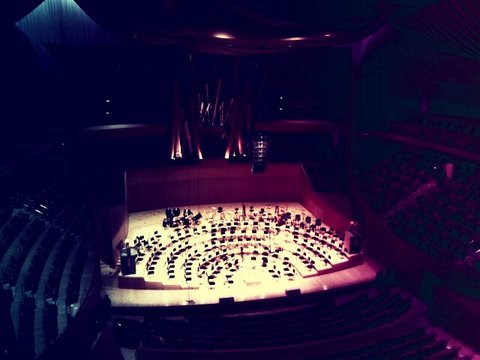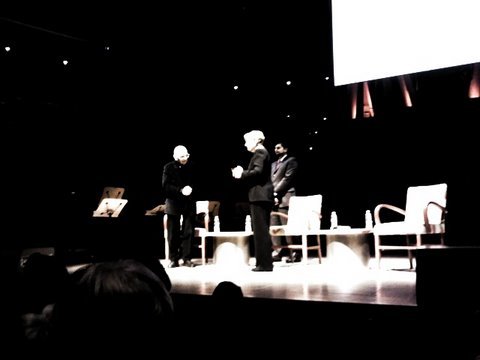
Reflections from our week at Take a Stand, a Symposium hosted by the Los Angeles Philharmonic, Bard College, and the Longy School of Music.
A national movement: the numbers and our values
As of January 2012 and according to the NEC Fellow’s national needs assessment survey presented at Take a Stand, there were 54 El Sistema inspired program in operation in the United States. Some of these programs are independent; some are connected to professional and youth orchestra educational frameworks; to public and charter schools; and community centers and churches. The majority of them are located in the Northeast, California, Midwest, and South regions. 71% of all programs are hosted at schools, 26% in community centers. Most students in programs receive 6-10 hours of weekly musical instruction. On average, there are 119 students per site, with an approximate cost of $1700 per child (annually). Ensembles include symphony orchestra, choirs, bucket bands, and mariachi. There are currently 6317 students actively participating in Sistema programs in the United States. In total, programs have raised approximately 11 million dollars in funding.
El Sistema in Venezuela, as noted by Eduardo Mendez, FundaMusical Bolivar’s executive director, currently oversees more than 280 sites and serves approximately over 300,000 students nationwide. The program, that began in 1975 with 11 students rehearsing in a parking garage, has now blossomed into a world class orchestral program and global phenomenon--with the help of countless individuals, teachers, and students inspired by Maestro Abreu’s powerful mission. To my knowledge, there aren’t any records available of El Sistema’s early growth and expansion. That being said, I’ve heard from alumni of El Sistema, that within three years, there were approximately 400 students enrolled in Abreu’s youth orchestras in Caracas. Start small, think big is Abreu's premise.
Ultimately, it is quality that matters over quantity. Programs that focus on providing the highest quality of instruction, ensemble experience, and teacher development quickly achieve meaningful success. When I led Sistema programs in Mexico, because we focused our energies into maximizing the extent of our resources, we saw the level of engagement, musical competence, and social development of our participants reach to remarkable heights, even just after a couple of months.
As Maestro Abreu noted at Take a Stand, even his very first Sistema orchestra, a handful of youngsters from Caracas, made an early mark in the international scene. Founded in 1975, within fours years, it quickly rose to international prominence by touring in Mexico and capturing the attention of Carlos Chavez, the revered Latin American composer; and also by participating in the World Youth Orchestra Festival in Aberdeen (as a result, 25 Venezuelans were selected to participate in a concert at the Royal Albert Hall, under Walter Susskind). It was Abreu’s relentless work ethic, a strong artistic mission, and vision for youth development of the highest order that produced meaningful results, even from the very beginning.
When we asked American program leaders to share an anecdote that embodied the core values of their programs, the idea of a sustainable development of youth through music resonated strongly among all of the programs. 22 programs specifically cited this notion as a primary impact of their programming. Community development, musical excellence, and access were also part of collective values. As these four pillars implie, it is clear that the Sistema movement in the United States recognizes that music, in its infinite variety, can serve as an instrument for social transformation. As a designated learner in the field, through this process I learned that program building is a process of inquiry rather than a set of instructions. And that success is dependent on our own abilities to embrace the notion of striving towards a state of excellence, an essential part of our work.

Jose Antonio Abreu, Deborah Borda, and Rodrigo Guerrero on the stage of Disney Hall.
Connecting a movement
The Symposium provided many opportunities to continue the conversations beyond the three-day convening. Polly Khan, the Vice President for Leadership Development at the League of American Orchestras offered her insight on the League’s role in supporting the Sistema movement in the United States. As many existing programs are connected to orchestra leadership (Hartford, Allentown, Baltimore, San Diego and San Antonio Youth, to name a few) the League is now hosting an El Sistema discussion group on League360, their new online community of orchestra administrators and musicians. The interface is very easy to navigate, visually engaging, and should be a wonderful tool for members to keep connected and share resources. There are more than 150 members listed on the site already (and there is no need to be a member of the league to join the discussion group).
During a symposium session hosted by Beth Babcock (CEO, Crittenton Women‘s Union) and Stanford Thompson (Founder, Play-on, Philly!) a group of US Sistema program directors gathered to gauge interest into the creation of an association for music programs catered to at-risk youth. The group presented the findings of a brief independent survey that indicated that a potential association would consider, at the forefront, building a national pipeline of data and outcomes evaluation for similar and related programs. This in response to meeting the guidelines of existing trends of philanthropic funding which stress providing strong evidence of program success through both quantitative and qualitative program outcomes measurements. During our opening symposium presentation, Where are we now?, my colleague Ben Fuller, pointed out the need for evaluation for sustainability as he told the story of D.A.R.E., a youth and drug prevention program that failed to meet evaluation standards and soon lost its federal funding. Perhaps, an association could serve as an advocacy group and potential platform for soliciting funding for local Sistema programs at the national level.
During the closing keynote, Deborah Borda, the president of the LA Philharmonic, alongside Karen Zorn and Leon Botstein, proposed the idea of embracing an open and flexible collaboration among existing programs in the United States. Their Take a Stand partnership, specifically entails a Masters in Teaching program from Bard College and the Longy School of Music. As well as hosting workshops and national conferences to support the growing national and international movement (the next conference is already in the works). That being said, it is my understanding that Take a Stand does not contemplate the creation of a national El Sistema service organization (or at least, not in the immediate future). This three-way partnership is a first for American orchestras. The LA Philharmonic sees itself at the forefront of innovation bridging both artistic and social imperatives. And should be commended for inspiring other orchestras in this path.

NEC Fellows at Santa Monica Beach, during our last day in California.

